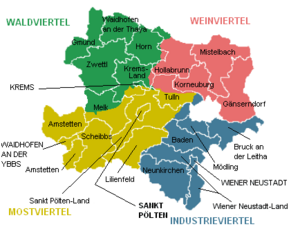Waldviertel facts for kids
The Waldviertel (which means Forest Quarter) is a special region located in the Austrian state of Lower Austria. It's known for its beautiful forests, rolling hills, and ancient granite rock formations. This area is a wonderful place to explore nature and learn about Austrian history and culture.
Contents
What is the Waldviertel?
The Waldviertel is one of four main regions in Lower Austria. Its name, "Forest Quarter," perfectly describes it because it has many large forests. It's a bit cooler and higher up than other parts of Austria, making it feel very natural and peaceful.
Where is the Waldviertel Located?
This region is in the northwestern part of Lower Austria. It borders the Czech Republic to the north. To the west, it touches the Austrian state of Upper Austria. The Danube River forms part of its southern border, and to the east, it meets another region of Lower Austria called the Weinviertel.
A Land of Forests and Rocks
The landscape of the Waldviertel is unique. It's part of the Bohemian Massif, which is a very old mountain range. This means you'll see lots of granite and other ancient rocks. These rocks often form interesting shapes, sometimes even looking like giant stone mushrooms! The many forests are mostly made up of spruce, pine, and fir trees.
Rivers and Lakes
Several rivers flow through the Waldviertel, like the Kamp River, the Thaya River, and the Lainsitz River. These rivers create beautiful valleys and are important for the local environment. There are also many small ponds and lakes, some of which are used for fish farming, especially for carp.
What's the Weather Like?
The Waldviertel has a cooler climate compared to other parts of Austria. Summers are usually mild, and winters can be quite cold with snow. This climate is perfect for the forests and the types of plants and animals that live there.
A Glimpse into History
The Waldviertel has a long history, dating back thousands of years. People have lived here since the Stone Age. Over time, castles and monasteries were built, showing the region's importance in medieval times.
Early Settlements
Archaeologists have found tools and signs of early human life in the Waldviertel. The first permanent settlements appeared as people started farming the land. The dense forests provided protection and resources.
Castles and Monasteries
During the Middle Ages, many castles were built to protect the borders and trade routes. Some of these, like Rosenburg Castle, are still standing today and can be visited. Monasteries, such as Zwettl Abbey, also played a big role in developing the region, bringing knowledge and new farming methods.
Life and Economy in the Waldviertel
Life in the Waldviertel has always been connected to its natural resources. Forestry, farming, and traditional crafts have been important for centuries. Today, tourism is also a big part of the economy.
Farming and Forestry
Agriculture is still important, with farmers growing crops like potatoes, rye, and oilseed poppy. The forests are carefully managed, providing wood for building and other products. Many people work in forestry, making sure the forests stay healthy.
Traditional Crafts
The Waldviertel is famous for its traditional crafts. For example, it's known for making linen fabric, glass, and granite products. These crafts have been passed down through generations and are a big part of the region's cultural heritage.
Tourism and Recreation
With its beautiful nature, the Waldviertel is a popular place for tourists. People come here for hiking, cycling, and enjoying the peaceful countryside. There are also many wellness hotels and spas, using the natural resources like water and herbs.
Fun Things to Do
- Explore Castles: Visit old castles like Rosenburg or Weitra Castle to learn about knights and medieval times.
- Go Hiking or Biking: There are many trails through the forests and along the rivers, perfect for outdoor adventures.
- Visit Mohnwirt: In the summer, you can see fields of blooming oilseed poppy, which is used to make poppy seed oil and delicious pastries.
- Discover Stone Formations: Look for the unique granite rock formations, some of which are called "Wackelsteine" (wobbling stones) because they seem to balance precariously.
Nature and Wildlife
The Waldviertel's diverse landscape supports a variety of plants and animals. The forests, rivers, and ponds create different habitats for wildlife.
Forests and Plants
The dominant trees are spruce, pine, and fir, but you can also find oak and beech trees. In spring, the forest floors are covered with wildflowers. Many types of mushrooms also grow here, especially in autumn.
Animals of the Waldviertel
The forests are home to deer, wild boar, foxes, and badgers. Birdwatchers can spot various species, including owls and woodpeckers. The rivers and ponds are home to fish like carp and trout, as well as amphibians and water birds.
See also
 In Spanish: Waldviertel para niños
In Spanish: Waldviertel para niños


